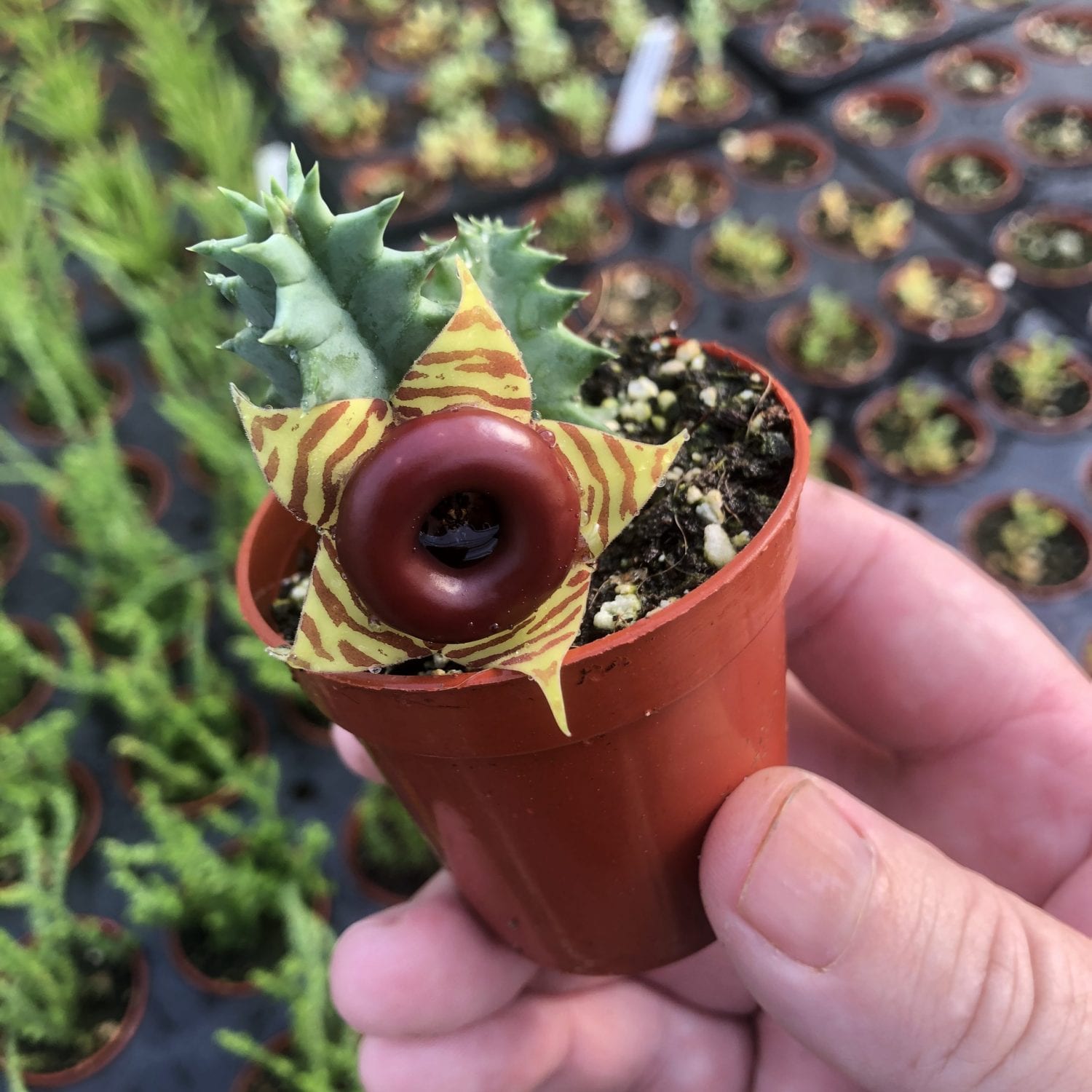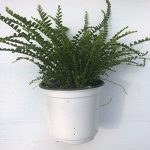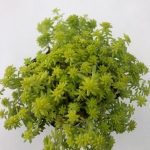Huernia zebrina, Lifesaver Plant (Lifesaver Cactus)
Price range: $6.99 through $14.99
Plant, Zone 9+
Discount per quantity
| Quantity | 3 - 8 | 9 - 14 | 15+ |
|---|---|---|---|
| Price | Price range: $6.78 through $14.54 | Price range: $6.57 through $14.09 | Price range: $6.29 through $13.49 |
| % Discount | 3% | 6% | 10% |
Description
Huernia zebrina (Lifesaver Plant): Candy-Ring Blooms, Zero-Stress Care
Why We Love the Lifesaver Plant
We all want a plant that makes people stop and smile. Huernia zebrina—also called the Lifesaver Plant or Lifesaver Cactus—does that the moment it blooms. Each starry flower shows bold zebra stripes around a glossy donut-shaped ring. It looks like candy tucked in the center. In other words, it’s playful, surprising, and unforgettable.
The plant itself stays neat and compact. Thick green stems form low clumps with soft little teeth along the edges. No spines. No drama. The habit fits on a sunny sill, a shelf, or a small plant stand. It’s a succulent, so it stores water in those stems. That means easy care for busy days and warm rooms.
Color is the headline, but texture is the secret. The stems have a sculpted look that reads modern and clean. When the flowers appear—usually in warm months—you get a burst of pattern and shine. The ring (the “lifesaver”) is glossy red to burgundy. The petals show cream to yellow with maroon bars. It’s a tiny piece of living art.
This plant is part of the stapeliad group, a tribe of odd and wonderful succulents from southern Africa. They’re famous for star-shaped blooms and wild designs. Huernia zebrina is one of the friendliest members for indoor growers. It asks for bright light, fast-draining soil, and a calm watering rhythm. That’s it. It rewards us with steady growth and those one-of-a-kind flowers.
A quick note on scent. The blooms have a faint, quirky smell that attracts pollinators in nature. Most of us notice it only when our nose is very close. It’s brief and mild indoors, more like an earthy, sweet note than anything strong. Place it near a window and you’ll enjoy the show without a fuss.
Quick highlights
- Look: Zebra-striped star flowers with a glossy donut-like ring
- Habit: Low, clumping succulent with soft, toothed stems
- Light: Bright, indirect light; gentle morning sun is great
- Water: Infrequent, deep watering; let soil dry fully between drinks
- Soil: Gritty, fast-draining cactus/succulent mix
- Bloom time: Warm seasons with good light; often summer to early fall
- Size: 4–6″ tall, 6–12″+ wide over time
- Hardiness: Frost-tender; best indoors or in Zones 10–11 outside
- Pets & family: Not for eating; sap may irritate sensitive skin—keep out of nibble range
What you’ll receive
A healthy, well-rooted Huernia zebrina in its nursery pot. Size and fullness vary by season, but every plant is hand-selected for clean growth, firm stems, and active tips. It arrives ready to settle in, grow, and bloom with you.
Simple Care That Works (Light, Water, Soil, and Everyday Rhythm)
Great results start with bright light and a breathable mix. After more than a few weeks in the right spot, you’ll see fresh tips and new buds forming along the lower stems. The routine below keeps it happy.
Light
Set your plant where it gets bright, indirect light most of the day. An east window with morning sun is ideal. A few feet back from a south or west window also works if you use a sheer curtain. Too little light makes stems stretch and pale. Too much harsh sun can scar tissue. In other words, keep it bright but kind.
Water
Think “soak and dry.” Water deeply until liquid drains, then let the mix dry completely before you water again. Use your finger or a moisture meter near the bottom of the pot. If it still feels cool and damp, wait. Overwatering is the only real enemy here. In warm seasons, you may water every 10–14 days. In cool seasons, you may wait 3–4 weeks. Consistency beats a calendar.
Soil & pot
Huernia zebrina loves air around its roots. Choose a gritty cactus/succulent mix and boost it with extra perlite or pumice. A simple blend that works:
- 2 parts cactus mix
- 1 part perlite or pumice
- ½ part fine bark or coarse sand
Pick a pot with a true drain hole. Shallow, wide pots suit clumping roots. Terracotta breathes and helps prevent soggy soil. Glazed pots hold moisture longer—nice in very dry homes—but watch your watering interval.
Feeding
Feed lightly in spring and summer. A gentle, balanced fertilizer at one-quarter to half strength once a month is enough. Avoid heavy feeding. Too much nitrogen makes soft growth that marks easily. We want compact, sturdy stems and high-contrast blooms.
Temperature & humidity
Room temperatures from 65–85°F are perfect. Keep it above 55°F. Protect from cold drafts and sudden chills. Average home humidity is fine. No misting needed. Dry air is not a problem when watering is right.
Dormancy & winter rest
As days shorten and rooms cool, growth slows. Reduce watering and stop feeding. Let the mix dry a bit longer than in summer. This calm period sets the stage for stronger spring growth and better flowering later.
Common issues & easy fixes
- Mushy stems or blackened bases: Overwatering or poor drainage. Unpot, cut back to firm tissue, dust the cut with sulfur or cinnamon, and re-root in dry, fresh mix.
- Wrinkled, thin stems: Thirst or roots bound by old soil. Water deeply and check that roots are healthy. Repot if the mix has broken down.
- Sun scald (bleached, rough patches): Light is too harsh. Shift to a brighter but filtered spot.
- Mealybugs or root mealybugs: Inspect joints and roots during repotting. Rinse gently, treat with a succulent-safe insecticidal soap, and refresh the mix. Good airflow helps a lot.
- No blooms: Light is low, or watering stayed too frequent in winter. Increase light, let the plant rest cool and dry in winter, then resume gentle feeding in spring.
Everyday care checklist
- Bright, indirect light with gentle morning sun
- Deep watering, then full dry-down
- Gritty mix + real drainage hole
- Light feeding in warm months only
- Avoid cold, drafts, and waterlogged soil
- Inspect stems and roots during your spring refresh
Styling, Blooming, and Propagation (From One Plant to Many)
Huernia zebrina is small, so styling is easy. It adds a sculptural, modern note without taking over the room. The flowers do the talking; the clump does the framing. Instead of crowding it, give it a little stage and let that candy-ring shine.
Where it shines
- Sunny sills: East-facing sills give gentle morning sun and crisp silhouettes.
- Shelf moments: A low pot on a light shelf reads like a tiny desert landscape.
- Grouped displays: Pair with haworthia, gasteria, or euphorbia for a calm, architectural set.
- Office corners: Bright desk spots keep it cheerful with almost no fuss.
Design ideas that always work
- Contrast the shapes: Round pot + angular stems = instant balance.
- Neutral tones: Terracotta or stoneware makes the flowers pop on bloom day.
- Mini landscape: Top-dress with pumice or pea gravel for a finished look and cleaner watering.
- Height play: Set on a short stand to bring buds closer to eye level.
How to encourage blooms
Give it the right seasons. In spring and summer, provide bright light, gentle feeding, and a steady soak-and-dry cycle. In late fall and winter, ease off water, skip feeding, and keep it cool but not cold. That rest tells the plant to set buds when warmth returns. Being slightly pot-bound can also help. In other words, lean conditions in winter, kind energy in summer, and the rewards will come.
Propagation—simple and fast
Instead of buying more, we can make more. Stem cuttings root readily when you let them callus.
- Take a cutting. Snip a firm stem section 2–4 inches long.
- Let it callus. Set the cutting in a dry, shaded spot for 2–5 days until the cut end looks sealed.
- Set in mix. Place the callused end into dry, gritty soil. Do not water yet.
- Wait, then water. After 5–7 days, mist lightly or give a small drink around the edge of the pot.
- Bright light, warm temps. Roots form within a couple of weeks in good conditions.
- Grow on. Resume the normal soak-and-dry rhythm once you see new growth.
You can also divide a crowded clump during spring repotting. Gently tease offsets apart, allow any broken surfaces to callus, and pot each section on its own. It’s quick, clean, and gives instant fullness.
Specs at a glance
- Botanical name: Huernia zebrina
- Common names: Lifesaver Plant, Lifesaver Cactus (a succulent, not a true cactus)
- Origin: Southern Africa
- Mature size: 4–6″ tall, clumping to 12″+ wide
- Flower size: About 1.5–2″ across with a raised “lifesaver” ring
- Light needs: Bright, indirect; gentle sun best
- Watering: Infrequent; full dry between soakings
- Soil pH: Slightly acidic to neutral is fine
- Toxicity: Not edible; sap may irritate—handle with care
- Outdoor use: Containers in frost-free climates or summer patio display; bring in before cool nights
What makes our plants different
We choose sturdy, well-rooted specimens with firm stems and clean growth points. Each plant is inspected, top-dressed, and packed to keep the clump secure in transit. You get a plant that settles fast, holds shape, and is primed for bloom in season.
Troubleshooting at a glance
- Stems soft? Too much water. Dry out, refresh the mix, and trim to firm tissue.
- Stems shriveled? Thirst. Water deeply, then return to the normal rhythm.
- No flowers? Increase light and give a cool, dry winter rest.
- White fuzz in joints? Mealybugs. Rinse, treat gently, improve airflow, and check roots during the next repot.
Candy Rings, Calm Routine—Bring the Wonder Home
Let’s grow a plant that feels like a tiny celebration. Huernia zebrina gives us bold pattern, glossy candy-ring blooms, and care so simple it slides into any week. Bright light. Gritty mix. Soak, then dry. After more than a few sunny days, you’ll spot buds along the stems—and then that perfect, playful star. Instead of juggling fussy divas, we can enjoy a small, sturdy showstopper that makes every windowsill a little happier. Bring home the Lifesaver Plant and watch the smiles appear.
Additional information
| Weight | N/A |
|---|---|
| Options | 2 in. (3 fl.oz.) Pot, 4 in. (16.9 fl. oz.) Pot |





